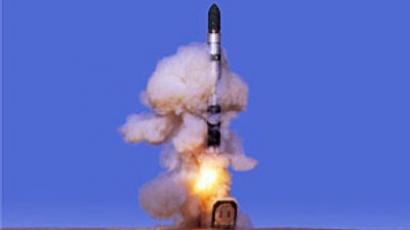Russia successfully tests ballistic missiles
The Russian Navy and Army have performed four successful tests of different ballistic missiles, including the new SLBM Bulava missile, in just over a day.
The Bulava (Mace) RSM-56 missile was launched from Dmitry Donskoy, an Akula class heavy ballistic missile submarine, at 05:10 Moscow time on Friday, from the White Sea in Russia’s north. Twenty minutes later, having traveled approximately 8,000 kilometers, its hypersonic maneuverable warheads hit targets at Kura shooting ground in Russia’s Far East Kamchatka region.
After a series of previously unsuccessful tests, the production control was toughened and it seems the previous faults were corrected. The new missile from now on will be tested on the submarines for which it was made – fourth generation Borey class ballistic missile submarines. The next launch will take place in December from the Yury Dolgoruky submarine.
Bulava missiles are set to be the cornerstone of Russia’s nuclear triad for at least the next 30 years. Armed with six to ten multiple independently targetable supersonic warheads that cannot be intercepted by any known system, the missile can sustain a nuclear blast several hundred meters away.
Experts agree that Bulava’s technical characteristics will guarantee that Russia will reserve its leading position in the world nuclear club well into the middle of the 21st Century.
Another launch was made from the Barents Sea by the Bryansk ballistic missile submarine, with a RSM-54 Sineva (Azure) missile, also hitting targets at the Kura range in the Kamchatka region. The Sineva missile has been in service in the Russian Navy since 2007, with 16 of them on every project 667 Dolphin class submarine. The missiles can be launched from 55 meters underwater. They are fully autonomic with celestial correction and are designed to pinpoint hard targets.
The third launch was performed from the Pacific, the Sea of Okhotsk, from the strategic ballistic missile submarine Svyatoy Georgy Pobedonosets (St. George the Victorious) project 667BDR Squid class. The launch was made to confirm the reliability of Soviet-made RSM-50, Stingray NATO classification, missiles. Its warheads successfully reached the Chizha range on the Kanin peninsula in the Arkhangelsk region.
The day before, on October 28, a Topol ballistic missile was launched from Plesetsk cosmodrome in Russia’s northern Arkhangelsk region. The missile was produced back in 1987 and was operational at Teikovo military installation until August 2007. After that it was stored at a military facility and 23 years after production, it successfully blasted off from Plesetsk cosmodrome, confirming that the operational lifespan of Topol ballistic missiles could be extended to at least 23 years.













